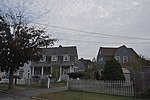Elihu Akin House
1762 establishments in the Province of Massachusetts BayDartmouth, MassachusettsHouses completed in 1762Houses in Bristol County, Massachusetts
The Elihu Akin House is a house in Dartmouth, Massachusetts, United States. It was built in 1762 by carpenter Jon Mosher. The house was later owned by the Akins, who were a prominent local family; Elihu Akin moved into the house after his own former home had been destroyed in a British raid. At the start of the 21st century, the house was extensively renovated. The Dartmouth Heritage Preservation Trust and the town of Dartmouth now own the house.
Excerpt from the Wikipedia article Elihu Akin House (License: CC BY-SA 3.0, Authors).Elihu Akin House
Dartmouth Street,
Geographical coordinates (GPS) Address Nearby Places Show on map
Geographical coordinates (GPS)
| Latitude | Longitude |
|---|---|
| N 41.596222222222 ° | E -70.941861111111 ° |
Address
Dartmouth Street 762
02748
Massachusetts, United States
Open on Google Maps










